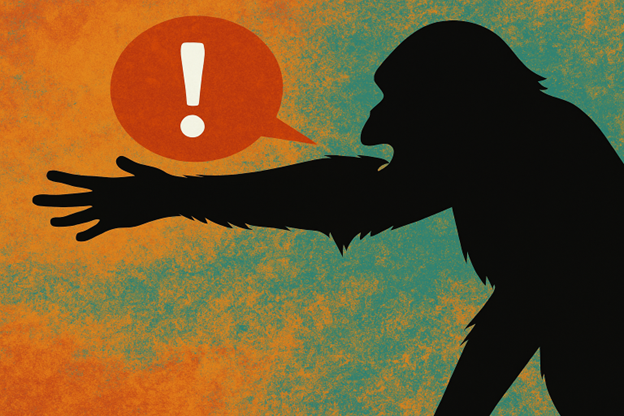By Erin E. Hecht
When I ask a classroom of Harvard students what makes humans different from our closest living relatives – chimpanzees and bonobos – invariably, one of the first answers is, “Language.” But how did this capacity evolve? For many years, researchers have debated whether the foundations of language emerged in the gestural domain or the vocal domain. Notably, all nonhuman ape species have a rich system of gestural communication. They also communicate vocally.

In nonhuman apes, an open, outstretched hand often has the same meaning as in human communication: a request to give something. Image created using DALL-E based on an original photograph by Frans de Waal at the Emory National Primate Research Center. The young chimp pictured had just had some food stolen by another individual.
In humans, the neural basis of language includes the arcuate fasciculus, a white matter pathway that connects frontal motor regions involved in language production with temporal perceptual regions involved in language comprehension. This human network is involved in both spoken and signed language and is significantly larger in the left hemisphere of the brain. Chimpanzees also have an arcuate fasciculus, but the extent to which it is involved in vocal and/or gestural communication was previously unknown.
To address this, we analyzed diffusion-weighted MRI scans in 67 chimpanzees. In collaboration with Bill Hopkins at the University of Texas, we assessed the extent to which individual variation in the arcuate fasciculus was related to communicative gestures and sounds. A human experimenter sat in front of the chimps’ enclosure with a stash of food and waited for chimps to “ask” for some of the food using either an outstretched hand gesture with alternating glances between the food and the experimenter, or with communicative sounds. We specifically focused on communicative sounds that have been previously shown to be under volitional control in chimpanzees: “raspberries,” which sound like a Bronx cheer, “kisses,” which sound like the name implies, and extended food grunts. (Many nonhuman primate vocalizations are thought to be more akin to human laughter or crying and may be less volitionally controlled.)
We found that individual variation in the chimpanzee arcuate fasciculus is significantly predictive of both communicative gestures and sounds. Moreover, while the chimpanzee arcuate fasciculus is not leftwardly-asymmetric at the population level, it is significantly more asymmetric in male chimpanzees who produced more volitional communicative sounds. Notably, these sounds are made in captivity to capture the attention of humans, but in the wild, chimps make these sounds during grooming sessions, particularly between male dyads, apparently to signal friendly intentions. In chimpanzee societies, partnerships between males are crucial for navigating status hierarchies and gaining access to mating opportunities. This suggests that increasing control over volitional communicative sounds could have arisen in the context of these relationships and the fitness benefits they entail.
These findings point toward a very deep origin for the foundations of language. Because shared neural substrates for vocal and gestural communication exist in both modern humans and modern chimpanzees, this was likely also the case in our last common ancestors, who lived 6-7 million years ago. This challenges the notion that language evolved solely from either gestural or vocal communication and instead supports a model where both modalities together contributed to the emergence of language.
What’s next? Research in our lab is currently examining brain changes associated with learning to use pictograms or American Sign Language in famous apes like Koko and Kanzi. Through this work, we hope to shed light on the extent to which human differences in language circuits are purely the result of evolved genetic change or are also culturally scaffolded by social experience.
Erin Hecht is an Assistant Professor of Human Evolutionary Biology at Harvard University.
Learn more in the original research article:
Individual variation in the chimpanzee arcuate fasciculus predicts vocal and gestural communication.
Hecht, E.E., Vijayakumar, S., Becker, Y. and Hopkins, W.D., 2025. Nature Communications, 16(1), p.3681.
News Types: Community Stories
